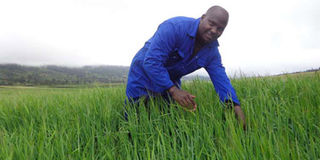With insurance, erratic rains and diseases don’t bother me

Simon Kinyanjui on his barley farm in Mau Summit. It is advisable that smallholder farmers also take insurance covers against unpredictable climate changes. PHOTO | LEOPOLD OBI | NATION MEDIA GROUP
What you need to know:
- Heavy rains or chilly weather accompanied with frost causes a burning effect on the three staples, resulting into poor harvests and low returns.
- However, despite the diversity, the farmer knows that growing one crop to cover for the other can be riskier too in the face of the erratic weather.
- Unlike maize and other crops which need a lot of human agronomy, barley is purely mechanised, thus, farmers with large farms benefit due to economies of scale.
- Prof Joachim von Braun, Director of the Center for Development Research (ZEF), says that insurance covers take the risk out of agriculture making it a profitable venture for smallholder farmers.
Our vehicle slid left to right a couple of times as we drove down a muddy road deep into Mau Summit in Narok County.
After more than an hour of unforgiving bumpy ride, we finally arrived in Merili, a small agricultural town on the foot of the Mau Forest.
Acres upon acres of wheat, barley and potatoes stretched into the horizon.
Simon Kinyanjui, one of the large-scale farmers in the area, was on his barley farm inspecting the malts following heavy rains.
The crop would be due for harvesting in two months and Kinyanjui was concerned on the impact the rain would have on his harvest.
Wet weather is normally a big concern to farmers of his lot, who are growing wheat, barley and potatoes in Mau.
Heavy rains or chilly weather accompanied with frost causes a burning effect on the three staples, resulting into poor harvests and low returns.
Kinyanjui farms barley on 70 acres and Shangi potato variety on 20 acres.
Having incurred incurable losses growing a single crop, the farmer decided to diversify so that one crop covers for the other in an event of a poor harvest.
“The weather has become so unpredictable, if it is not a prolonged drought, then there are excess rains or frost,” offers Kinyanjui.
ERRATIC WEATHER
However, despite the diversity, the farmer knows that growing one crop to cover for the other can be riskier too in the face of the erratic weather.
Therefore, he has insured his barley farm.
Back in 2010, while growing wheat, Kinyanjui lost a huge chunk of his produce to frost. Like some farmers in Merili, Kinyanjui farms on a leased land at Sh5,000 per acre for a year.
“I decided to quit wheat because there was no assured market as compared to barley, which I started farming in 2013.
We sold our wheat through middlemen who paid less than Sh2,500 per 90kg bag, which was quite low,” explains Kinyanjui, who sells the produce to East African Breweries Limited at Sh3,285 per 90kg bag.
Unlike maize and other crops which need a lot of human agronomy, barley is purely mechanised, thus, farmers with large farms benefit due to economies of scale.
He started with 45 acres then increased the acreage to the current 70.
“I have insured my crop with one of the companies in Nairobi. They have an agronomist in Mau who took me through the modalities of taking an insurance cover,” notes Kinyanjui, adding frost is one of his biggest threat to the crop as the farm borders Mau Forest.
To get cover, Kinyanjui says one starts by informing the company of their intentions, detailing the type of crop, locality and acreage.
“The company will then offer you a quotation which you must pay the price in full. Quotation is either covering cost of production or expected yields.”
The latter is higher but covers one entirely. “You are not yet covered until they inspect the germination percentages of which if it’s poor they decline and refund you the money.”
ACCESS TO INSURANCE COMPANIES
He adds, “If it’s good enough, they confirm the cover and do at least two or more inspections thereafter. In case of disaster you inform them immediately so that they can send an assessor.”
The crops package covers losses caused by drought, uncontrollable pest and diseases, hailstone, flooding, malicious damage, riot and strike, fire and lightning.
In 2013, the farmer planted barley targeting 18 bags per acre but ended up harvesting losses due to frost. He was paid Sh1 million compensation.
James Papa, an agronomist at APA Insurance, says even smallholder farmers can take insurance against unpredictable climate change and the insurance can be on any other plants including maize, sorghum and vegetables.
“It is vital for farmers to take insurance cover for their crops so that they are covered. Most farmers avoid insurance due to lack of information. We normally have agronomist who visit our farmers to ensure good agricultural practices to avert any unnecessary losses,” says Papa.
Prof Joachim von Braun, Director of the Center for Development Research (ZEF), says that insurance covers take the risk out of agriculture making it a profitable venture for smallholder farmers.
“Government needs to set up infrastructure in rural areas to make them accessible for insurance companies to reach farmers. With such incentives in place, insurance companies are likely to lower premiums for smallholder farmers which in turn attracts more farmer to the services"
***
Get it Fast
Insurance Policy now a Priority
- Due to climate change, which has resulted in erratic weather, any serious farmer should embrace crop insurance.
- Floods, drought, frost and disease outbreaks like Maize Lethal Necrosis have become common, making insurance an urgent thing for the farmer.
- A farmer who is insured is better off than the one not covered. The problem, however, is that the cost of insurance is still high.
- Farmers need to assess their farms keenly and know the history of an area before leasing land.





